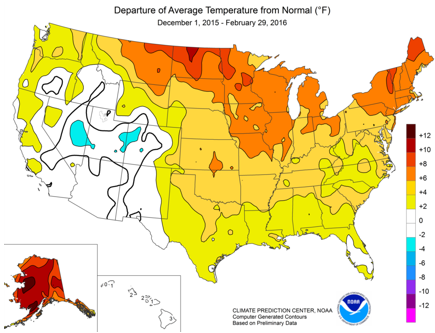April 2016, Vol. 243, No. 4
Web Exclusive
Strong El Niño Helps Reduce U.S. Winter Heating Demand

Above-normal temperatures during the 2015-16 winter were a key factor in lowering heating demand and winter fuel expenditures. Compared with the 2014-15 winter, propane and heating oil demand decreased by 16% and 45%, respectively, and residential electricity demand decreased by 6%. The 2015-16 winter season (October through March) was 15% warmer than last winter, driven in part by one of the strongest El Niño events in decades.
El Niño is a large-scale warming event that affects temperature and precipitation patterns in the Pacific Ocean. It occurs every three to five years, and it is caused by warmer-than-normal ocean temperatures in the east-central equatorial Pacific. El Niño events typically last 9 to 12 months. The 2015-16 El Niño was one of the three strongest on record, and contributed to the warm winter weather experienced in the United States.

Highlights for the four most common heating fuels include:
Natural gas. Nearly half of all U.S. homes use natural gas for space heating. Residential natural gas prices during the winter of 2015-16 were about 5.6% lower than in the previous winter. Throughout this past winter, natural gas inventories remained high. As of April 7, working natural gas in underground storage increased to 1,472 billion cubic feet, 69% higher than the level at the same time in 2015.
Heating oil. Prices for petroleum-based fuel have also been lower because of falling crude oil prices. Residential heating oil prices were about 29% lower this winter compared with the previous winter. As the El Niño event dissipates and demand increases, refinery heating oil prices are forecast to increase 18% by next winter.
Propane. Residential propane prices remained relatively flat during the winter season, averaging $1.98 per gallon. As of April 1, 2016, U.S. propane stocks were up by 2.0 million barrels to 64.9 million barrels, 6.9 million barrels (11.9%) higher than a year ago. On average, U.S. households paid 15% less for propane this winter compared with the previous winter. In the Midwest, which uses more propane than other regions, prices declined by more than 22% from the previous winter.
Electricity. Electricity prices change more slowly than the prices of heating fuels because electricity rates in many areas of the country are set using regulatory mechanisms with long time lags. Residential electricity prices fell slightly, declining 0.5% from winter 2014-15 to winter 2015-16.






Comments